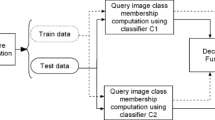Abstract
An adaptive feature fusion framework is proposed for multi-class classification based on SVM. In a similar manner of one-versus-all (OVA), one of the multi-class SVM schemes, the proposed approach decomposes a multi-class classification into several binary classifications. The main difference lies in that each classifier is created with the most suitable feature vectors to discriminate one class from all the other classes. The feature vectors of the unknown samples are selected by each classifier adaptively such that recognition is fulfilled accordingly. In addition, novel evaluation criterions are defined to deal with the frequent small-number sample problems. A writer recognition experiment is carried out to accomplish this framework with three kinds of feature vectors: texture, structure and morphological features. Finally, the performance of the proposed approach is illustrated as compared with the OVA by applying the same feature vectors for all classes.
Similar content being viewed by others
References
Dietterich T and Bakiri G (1995). Solving multiclass learning problems via error-correcting output codes. J Artif Intell Res 2: 263–286
Han J, Bhanu B (2004) Statistical feature fusion for gait-based human recognition. In: Proceedings of IEEE computer society conference on computer vision and pattern recognition CVPR’04, pp 842–847
Hsu C and Lin C (2002). A comparison of methods for multi-class support vector machines. IEEE Trans Neural Networks 13: 415–425
Kreßel U (1999) Pairwise classification and support vector machines. Advances in kernel methods-support vector learning. MIT Press, Cambridge, pp 255–268
Platt JC, Cristianini N and Shawe-Talor J (2000). Large margin DAG’s for multiclass classification. Adv Neural Inf Process Syst 12: 547–553
Rifkin R and Klautau A (2004). In defense of one-vs-all classification. J Mach Learn Res 5: 101–141
Said HES, Tan TN and Baker K (2000). Personal identification based on handwriting. Pattern Recognit 3: 149–160
Schölkopf B, Burges C, Vapnik VN (1995) Extracting support data for a given task. In: Proceedings of 1st international conference on knowledge discovery and data mining KDD’95, pp 252–257
Vapnik VN (1998). Statistical learning theory. Wiley, London
Weston J, Walkins C (1998) Multi-class support vector machines. Technique Report CSDTR-98-04. University of London, Department of Computer Science, Royal Holloway
Zhou J, Zhang D (2002) Face recognition by combining several algorithms. In: Proceedings of 16th international conference on pattern recognition ICPR’02, pp 497–500
Author information
Authors and Affiliations
Corresponding author
Rights and permissions
About this article
Cite this article
Yin, P., Sun, F., Wang, C. et al. An adaptive feature fusion framework for multi-class classification based on SVM. Soft Comput 12, 685–691 (2008). https://doi.org/10.1007/s00500-007-0250-3
Published:
Issue Date:
DOI: https://doi.org/10.1007/s00500-007-0250-3




